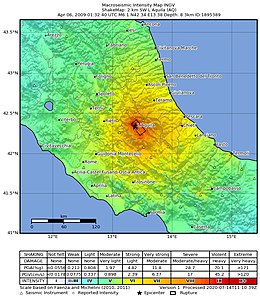2009 L'Aquila earthquake
 | |
| UTC time | ?? |
|---|---|
| Magnitude | 6.3 Mw |
| Depth | 10 km (6.2 mi) |
| Epicenter | 42°25′23″N 13°23′42″E / 42.423°N 13.395°E[1] |
| Areas affected | Abruzzo, |
| Casualties | 150+ dead[2] 1,500 injured[3] 30,000-40,000 displaced[4] |
The 2009 L'Aquila earthquake was an earthquake of 6.3 moment magnitude that occurred in the central Italian region of Abruzzo on 6 April 2009, following a series of about a hundred minor tremors since January 2009, including a 4.0-magnitude one on 30 March. The majority of the damage occurred in the medieval city of L'Aquila. Over 150 people are known to have died, making this the deadliest earthquake to hit Italy in almost 30 years.
Cause
The earthquake is likely to have been caused by movement in the north-south faultline which runs along the Apennine Mountain Range, although there is a smaller east-west faultline across the centre of the country which is typically associated with minor earthquakes.[5] The faultlines are related to the tectonic movement of the European and African Plates in a tectonically complex system which also includes micro plates.[5][1] The earthquake occurred at 01:32 GMT (03:32 CEST local time) at a depth of 10 kilometres (6.2 mi) and with an epicentre approximately 95 kilometres (60 mi) north-east of Rome, near to the city of L'Aquila.[4] The earthquake was reported to measure 6.3 on the moment magnitude scale.[1]
Historical context
Italy frequently experiences earthquakes but it is uncommon for them to be very deadly; the last major earthquake was the 5.9 magnitude 2002 Molise earthquake which killed more than 25 people and was the deadliest in 20 years.[5] Earthquakes mark the history of L'Aquila. The city was stricken by earthquakes in 1315, 1349, 1452, 1501, 1646, 1703, and 1706.[6]
Effects

The earthquake caused damage to between 3,000 and 10,000 buildings in the medieval city of L'Aquila.[4] Several buildings, including a university dormitory and churches, collapsed. Between 30,000 and 40,000 people have been made homeless, with 100,000 temporarily fleeing their homes.[4] More than 100 people were killed by the earthquake, including children, and around 1,500 people were injured.[4][7] As of 15:45, many people are reported missing and students are still trapped under the rubble of the collapsed dormitory. The main earthquake was preceded by two smaller earthquakes the previous day.[4] The earthquake was felt as far away as Rome, in other parts of Lazio, as well as Molise, Umbria, and Campania. Schools remained closed in the Abruzzo region. Most of the inhabitants of L'Aquila have abandoned their homes and the city itself; in the city centre of L'Aquila and the nearby town of Paganica which was also damaged, many streets are impassable due to fallen masonry. The hospital at L'Aquila, where many of the victims were brought, suffered damage in the 4.8 aftershock which followed the main earthquake an hour later. Aftershocks were felt throughout the morning and afternoon of 6 April.
Nearly all medieval monuments in L'Aquila have been damaged. The bell tower of the Basilica of Saint Bernardino of Siena, L'Aquila's largest Renaissance church, collapsed and its apse was seriously damaged. The 17th-century church of Anime Sante in Piazza Duomo lost its dome. The Cathedral of L'Aquila was not damaged.[8] The 13th-century Basilica di Santa Maria di Collemaggio collapsed from the transept to the back of the church and Porta Napoli, the oldest gate to the city, was destroyed in the quake. There were also concerns for the National Museum of Abruzzo, which is housed in the 16th-century castle. The cupola of the 18th-century Baroque church of St Augustine has collapsed, flattening the prefecture that held L'Aquila's state archives.[9]
Prior warning controversy
Italian laboratory technician Giampaolo Giuliani was said to have predicted the earthquake in advance, by measurement of radon emitted from the ground. He was dismissed as a scaremonger, and forced to remove his findings from the Internet. He was also reported to police a week ago for "causing panic" among the local population when he predicted an earthquake was imminent in Sulmona, about 50 km (31 mi) from L'Aquila, on 30 March and nothing happened (and in fact the area of Sulmona only suffered very minor damages by the 6 April earthquake).[10] Enzo Boschi, the head of the Italian National Geophysics Institute said "Every time there is an earthquake there are people who claim to have predicted it," he said. "As far as I know nobody predicted this earthquake with precision. It is not possible to predict earthquakes."[11]
References
- ^ a b c "Magnitude 6.3 - CENTRAL ITALY 2009 April 06 01:32:42 UTC". USGS. 2009-04-06. Retrieved 2009-04-06.
- ^ "Sisma Abruzzo: Oltre 150 morti, sei studenti estratti vivi" (in Italian). ANSA. 2009-04-06. Retrieved 2009-04-06.
- ^ "Dozens dead in Italian earthquake". CNN International. 2009-04-06. Retrieved 2009-04-06.
- ^ a b c d e f "Powerful Italian quake kills many". BBC News. 2009-04-06. Retrieved 2009-04-06.
- ^ a b c "Background: Italy and earthquakes". The Guardian. 2009-04-06. Retrieved 2009-04-06.
- ^ "L'Aquila, prov. of L'Aquila, Abruzzo". Abruzzo2000.com. Retrieved 2009-04-06.
- ^ "Quake: Over 100 dead, 1, 500 injured". ANSA. 2009-04-06. Retrieved 2009-04-06.
- ^ "EARTHQUAKE: CHURCHES DAMAGED IN L'AQUILA". Agenzia Giornalistica Italia. 2009-04-06. Retrieved 2009-04-06.
- ^ "Quake: 'Huge' artistic damage". ANSA. 2009-04-06. Retrieved 2009-04-06.
- ^ "Italy: State of emergency after deadly central quake". Adnkronos International. 2009-04-06. Retrieved 2009-04-06.
- ^ "Italian earthquake: expert's warnings were dismissed as scaremongering". Daily Telegraph. 2009-04-06. Retrieved 2009-04-06.
